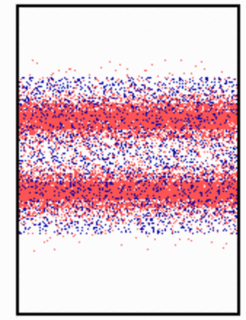Details: Models for insect midline
1. The insect solution: a dorsal organizer repels the midline to the ventral side
In the simulation below and on the previous page, an organizer (c, pink) at the dorsal side is assumed. It has an inhibitory influence on a second pattern forming system that has stripe-forming capabilities (red).

The stripe forms simultaneously along the full anteroposterior axis but sharpens in the course of time towards ventral, in agreement with the observation of Chen et al. (2000) for Tribolium.
Simulation above calculated with the following set of equations:
1. The activator and inhibitor of the spot system:


2. The activator and inhibitor of the stripe system:


Due to the cross-inhibition of the inhibitor of the spot system (b) onto the stripe system (term sbb), stripe formation is restricted to the antipodal side. Calculated with the following parameters:
Da = 0.003; r a = 0.01; ba = 0; sa = 0; Db = 0.2; rb = 0.015; bb = 0
autoregulatory production rate s = 0.01 + 1% fluctuation; Dc = 0.0015; rc = 0.01; bc = 0; Dd = 0.2; r d = 0.015; cross-reaction s b = 0.2; autoregulatory production rate: Rc = 0.01 + 1% fluctuation;
Without the organizing influence of the organizer, stripes would still be formed but their orientation would be random; in agreement with the observation of Roth and Schüpbach (1994):
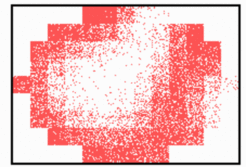
2. A more refined model
The wide plateau-like pipe distribution gives rise to a sharp midline. Due to the repression from the dorsal organizer via gurken and the threshold-behavior of pipe, pipe has a plateau-like distribution. For the conversion of this plateau-like pattern into the final midline signal it is assumed that a diffusible precursor is generated in those cells in which pipe is active. Although the cascade that generates the final signal is highly complex, it is proposed that it can be described by assuming that the precursor becomes converted into the final signal whereby a strong positive feedback of the final signal onto the rate of conversion plays a crucial role. An elevated local conversion rate leads to a depletion of precursor molecules in a more extended region, exerting a lateral inhibition of the self-enhancing process. As shown in the simulation below, the flat pipe activation (blue) leads first to an even broader distribution of the precursor (green). At the highest precursor concentration the conversion is triggered that leads to a sharp signal (red).
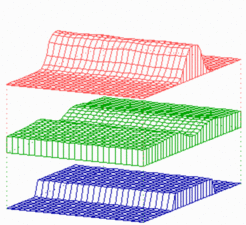
Thus, the model requires two equations: (i) The formation of the precursor b generated or modified under pipe control (p(x) describes the pipe distribution, p(x) = 1 if pipe is on and 0 if pipe is off):

(ii) The autocatalytic signal production a goes on the expense of the precursor molecules b. The signal molecules are much less diffusible:

Calculated with the following parameters: Da = 0.005; r a = 0.005; ba = 0.02; sa = 0.03; Db = 0.2; rb = 0.0005; bb = 0.01;
autoregulatory production rate s = 0.01 + 1% fluctuation. In the plot below the same simulation is shown. The density of pixels indicates the signal concentration and pipe activation. That the evolving signal is much sharper than the pipe distribution is clearly to be seen:
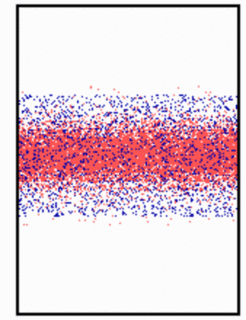
If pipe activation is broader, two midlines are formed. In the centre of the pipe region the signal is low, in agreement with the observation of Roth and Schüpbach, 1994.
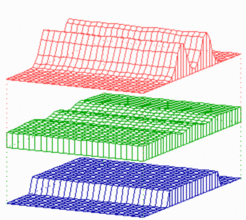
A plot with pixels shows that the two stripes do not appear at the borders of the pipe-domain but more in the centre, in agreement with the observation. This is non-trivial since if pipe would just enable the signal formation, a localization of the stripes at the borders would be nearly unavoidable due to the lateral inhibition mechanism: the non-pipe cells would exert no inhibition, therefore a pipe/non-pipe border would have a strong advantage. In the mechanism proposed, the pipe-expressing cells are only required to supply /modify a diffusible precursor. Therefore, the border is not attractive since no precursor is obtained from a region beyond the pipe region. Therefore, the even if two stripes are formed due to the enlarged pipe region, the two midline remain within the pipe region.
